
Andre Derain Boats at Collioure 1905

• For the first time since March 10 (!!!), Italy reported less than 1,000 new cases of coronavirus.
• The US had +20,329 new confirmed coronavirus cases today, the lowest number since late March, bringing the total to 1,367,638, of which 1,030,515 are still active.
Four US states are close to winning, ten more are on the way, a strong push and can be there. Way too many still need a lot of work but it's not too late to get on the road to victory.
For more information see:https://t.co/8nGyIMWS33 pic.twitter.com/phLILRxg4J
— Yaneer Bar-Yam (@yaneerbaryam) May 10, 2020
The same approach applies to other winning states. 14 day quarantines for arriving individuals are totally worth being able to open up an economy safely.
— Yaneer Bar-Yam (@yaneerbaryam) May 11, 2020
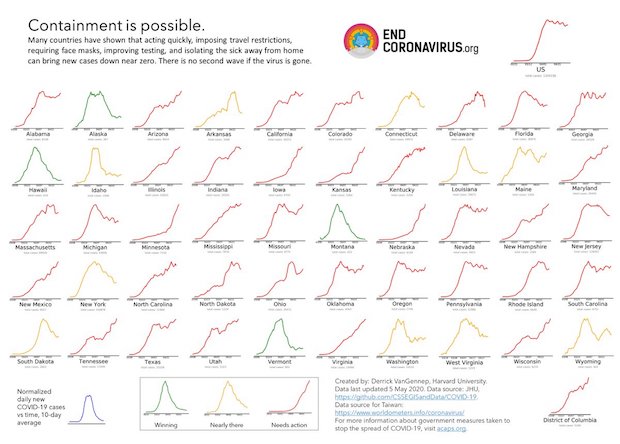
Click to enlarge in new tab

• Cases 4,200,957 (+ 79,179 from yesterday’s 4,121,778)
• Deaths 284,150 (+ 3,282 from yesterday’s 280,868)

From Worldometer yesterday evening -before their day’s close-
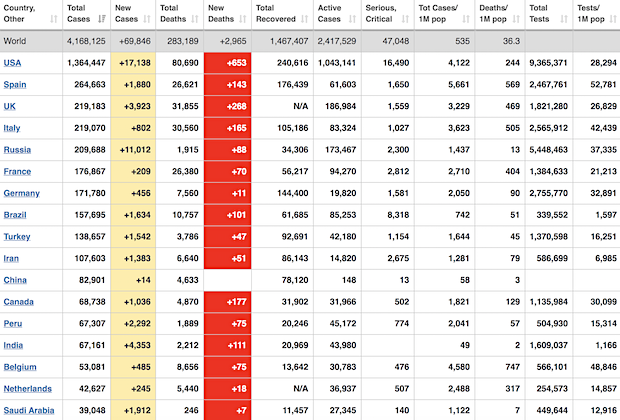
From Worldometer
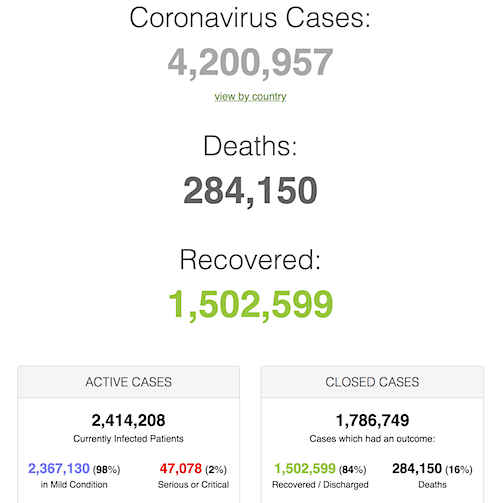
From SCMP:
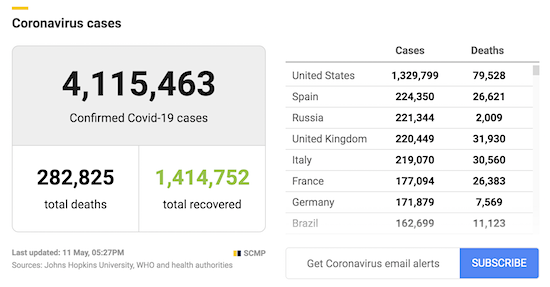
From COVID19Info.live:
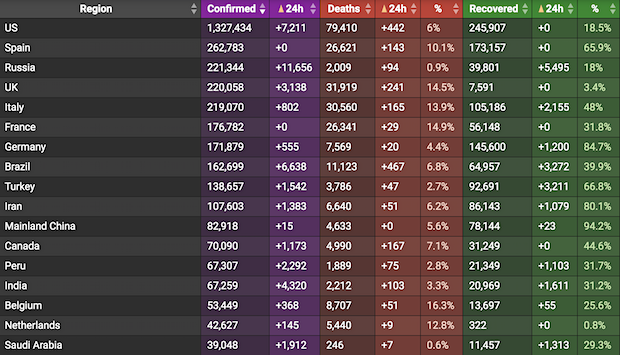

Open up!
• Wuhan Reports 5 New Coronavirus Cases, Its Highest Surge In 2 Months (RT)
Original hotspot of the Covid-19 pandemic, the Chinese city of Wuhan, has reported five new indigenous cases as the number of infections across mainland China has slightly grown as well. China reported seventeen new cases of the novel coronavirus on Monday – three more than the day before. Of the newly-detected cases, seven are linked to overseas travel, and 10 are believed to be the result of local transmission. In addition to five indigenous cases in Wuhan, three other came from Jilin province, one from Liaoning, northeastern Chinese province bordering North Korea, and another one from Heilongjiang province, bordering Russia.
While the figure might not sound that alarming, considering that China was adding thousands of cases mid-February, when it was going through the peak of the pandemic, it still marks the nation’s biggest jump in confirmed infections since April, 28. The latest data from Wuhan, which just late last month celebrated the recovery of the last patient with severe Covid-19, can be seen as a worrying sign as well since it the most significant increase in cases for the pandemic ground zero in two months. Last time Wuhan reported more than five new cases in a single day (8) was on March 11. However, it was not before the beginning of April when the last remaining travel restrictions imposed on the city, as it was fighting the outbreak, were lifted after 76 days of lockdown.
Around the same time, Wuhan for the first time reported zero daily deaths from the disease. Considering the steady drop in the number of new coronavirus patients, Beijing has gradually relaxed coronavirus measures across the country, on Thursday declaring the whole territory of China as ‘low risk” in terms of coronavirus. Apart from Hubei, there has been a surge in infections in Shulan, in the northeastern Jilin province, where all of the new cases are believed to be traced to a single woman. Concerned about the possible second wave of the desease, local authorities raised the risk level from low to medium last week.

Lockdowns work. In principle. That says little about their execution, but I already covered that. If people want to be skeptical of something, at least make sure you know what you’re skeptical about.
• New Zealand To Reopen Malls, Cafes From Thursday As Virus Curbs Eased (R.)
New Zealand businesses including malls, cinemas, cafes and gyms will reopen on Thursday after some of the tightest restrictions in the world to stop the spread of the coronavirus were further loosened on Monday. The Pacific nation was locked down for more than month under “level 4” restrictions that were eased by a notch in late April. It has continued to enforce strict social measures on many of its citizens and businesses, helping prevent widespread community spread of the virus. Prime Minister Jacinda Ardern said the staggered move to “level 2” restrictions will mean retail, restaurants and other public spaces including playgrounds can reopen from Thursday.
Schools can open from next Monday while bars can only reopen from May 21, Ardern said. Gatherings would be limited to 10 people. “The upshot is that in 10 days’ time we will have reopened most businesses in New Zealand, and sooner than many other countries around the world,” Ardern told a news conference. “But that fits with our plan – go hard, go early – so we can get our economy moving again sooner, and so we get the economic benefit of getting our health response right.” Businesses will be required to have physical distancing and strict hygiene measures in place. Air New Zealand announced it would resume seven more domestic routes when the country enters alert level 2.
International travel, however, would not be possible as borders will remain closed except for returning New Zealanders. The measures would be reviewed again in two weeks, Ardern said. The government plans to introduce a new law that would allow authorities to enforce physical distancing and control gatherings of people after questions were raised about the legality of lockdown rules. Three new cases of COVID-19 were confirmed on Monday, the health ministry said in a statement. The cases – two hospital nurses and one related to overseas travel – bring New Zealand’s total confirmed COVID-19 infections to 1,147, the ministry said, adding that 93% of all confirmed and probable cases have recovered.

New Zealand is 2,500 miles, 4,000 km, from Australia, its nearest neighbor. Amid all the hosanna, that must not be forgotten. European countries, for instance, have no such advantages.
New Zealand can simply close its doors. But yeah, they did it along with a strict lockdown.
• How New Zealand Put Coronavirus On The Brink Of Elimination (Wired)
On February 28, the news emerged of New Zealand’s first case of Covid-19. For Michael Baker, a government advisor and epidemiologist at the University of Otago in Wellington, the following weeks would be a time of extreme anxiety. While New Zealand is now regarded as a global success story in containing the coronavirus – as of May 7 it has reported just 1,489 cases and 21 deaths amongst a population of five million – this did not always appear such a likely outcome. Indeed, scientists believe that without the right strategies being swiftly implemented at crucial times, the country could have experienced more than 1,000 cases a day, overwhelming its fragile healthcare network.
When the news arrived that Covid-19 had reached New Zealand’s shores, Baker had already been monitoring the seemingly inexorable global progression of the pandemic since early January. He was well aware of the devastation wreaked by the virus in Wuhan, and grim reports were already filtering through of the worsening outbreak in Italy. While New Zealand’s relative geographical isolation had provided some protection thus far, he knew how swiftly the tide could turn. “It was the most intense period of my working life,” he says. “The distant drumbeat was getting louder and I felt we were on a knife edge in terms of what would happen.”
A member of the Ministry of Health’s technical advisory group, Baker had read the report of the World Health Organisation’s joint mission to China at the end of February. “It showed that the Chinese had done the almost impossible, they’d stopped a pandemic in full flight which was remarkable,” he says. “This showed that it was containable.” Inspired by this, and reports from fellow island nations such as Taiwan who had also managed to contain the outbreak, he realised that if New Zealand acted swiftly and strongly, it could prevent a disaster before it had even begun. He started calling for an approach to eliminate, rather than merely suppress the virus.
At that point – like most other countries – New Zealand was applying the same action plans for Covid-19 as with a bout of pandemic influenza, steadily ramping up their response as the pandemic progressed to try and mitigate it and flatten the curve. But while the rate at which influenza is transmitted means it is nigh impossible to stop, the data showed that Covid-19 was different. “The fundamental difference is that the virus incubation period is longer for Covid-19,” said Baker. “For influenza, it’s one to three days depending on what strain, and with Covid-19 it’s about five days on average. This means that contact tracing and quarantining contacts really does work if you do it quickly enough.”
Epidemiologists began advising the government to change strategy and implement a preventative full lockdown. This involved completely shutting the borders, and enforcing a maximum containment policy where the entire population bar essential workers were required to stay at home unless for medical reasons or food supplies. “We recommended going early and hard,” Baker says. “There are two advantages to that. First you prevent a lot of cases and deaths, and also if you control it early, there’s fewer chains of transmission that have to be stamped out and so your lockdown is likely to be for a shorter period of time.”

Not new, and this take reads a bit too much like a Big Pharma ad. And what does this mean: Inhibitors don’t lead to higher concentrations? Would be bad if they did, no?
“..widely-prescribed drugs called ACE inhibitors or angiotensin receptor blockers (ARBs) did not lead to higher ACE2 concentrations ..”
• Men Have High Levels Of ACE2 Enzyme Key To COVID-19 Infection (R.)
Men’s blood has higher levels than women’s of a key enzyme used by the new coronavirus to infect cells, the results of a big European study showed on Monday — a finding which may help explain why men are more vulnerable to infection with COVID-19. Angiotensin-converting enzyme 2 (ACE2) is found in the heart, kidneys and other organs. In COVID-19, the respiratory disease caused by the novel coronavirus, it is thought to play a role in how the infection progresses into the lungs. The study, published in the European Heart Journal, also found that widely-prescribed drugs called ACE inhibitors or angiotensin receptor blockers (ARBs) did not lead to higher ACE2 concentrations and should therefore not increase the COVID-19 risk for people taking them.
ACE inhibitors and ARBs are widely prescribed to patients with congestive heart failure, diabetes or kidney disease. The drugs account for billions of dollars in prescription sales worldwide. “Our findings do not support the discontinuation of these drugs in COVID-19 patients,” said Adriaan Voors, a professor of cardiology at the University Medical Center (UMC) Groningen in The Netherlands, who co-led the study. [..] Death and infection tolls point to men being more likely than women to contract the disease and to suffer severe or critical complications if they do. Analysing thousands of men and women, Voors’ team measured ACE2 concentrations in blood samples taken from more than 3,500 heart failure patients from 11 European countries.
The study had started before the coronavirus pandemic, the researchers said, and so did not include patients with COVID-19. But when other research began to point to ACE2 as key to the way the new coronavirus gets into cells, Voors and his team saw important overlaps with their study. “When we found that one of the strongest biomarkers, ACE2, was much higher in men than in women, I realised that this had the potential to explain why men were more likely to die from COVID-19 than women,” said Iziah Sama, a doctor at UMC Groningen who co-led the study.

Easy to see why the White House and Republican leadership have starting slow walking negotiations on CARES 4.0 when @SpeakerPelosi reportedly will propose $1 trillion for state and local governments. Revenue loss estimates dont justify anything near that #muniland https://t.co/kUDXDdmO3d
— Cate Long (@cate_long) May 11, 2020
• Inside House Democrats’ $1.2 Trillion+ Coronavirus Relief Proposal (Axios)
House Democrats could bring their phase 4 coronavirus relief package (CARES 2) to the floor for a vote as early as this week — but, for now at least, it’s going nowhere. The state of play: Democrats have crafted a $1.2 trillion+ package without input from the White House or Hill Republicans, congressional aides familiar with their plans tell Axios. • GOP leadership says it’s still waiting for billions of aid allocated in the first $2.2 trillion CARES Act to go out the door. • The White House says it wants to evaluate the economic impact of reopening before passing another large stimulus package. But House Democrats see the proposal as a way to lay down a marker of their priorities and prod congressional Republicans and the White House toward more economic relief for individuals, state and local governments, and the U.S. Postal Service.
Speaker Nancy Pelosi (D-Calif.) and her caucus also want to show voters that they’re still working, despite members remaining in their districts. Those optics could be important politically given the Senate’s decision to return to Washington last week. (House Republicans have been chiding Democrats for staying home in their districts when, they say, they should be at work.)
Details: The legislation, which is still being drafted and is subject to change, is expected to include:
• Roughly $1 trillion for state and local governments. They want to split this money into separate revenue streams to ensure each community can access it.
• More money for hospitals and COVID-19 testing.
• Roughly $25 billion to keep the U.S. Postal Service afloat.
• Expanded nutritional benefits, Medicaid funding and unemployment insurance (which they call “paycheck guarantee”).
• Another round of direct payments to Americans.House leadership is also working on narrowing down the guidelines for how these funds are allocated to ensure that people aren’t “double dipping” into the different pots of money, a senior Democratic aide told Axios. For example, they do not want someone who is receiving more unemployment money to also receive money through the Paycheck Protection Program. However, it’s still unclear whether the PPP fund will be replenished. “We’re trying to limit the amount of overlap so people aren’t abusing the system,” the aide said. The package will not include liability protection for businesses, which Senate Majority Leader Mitch McConnell (R-Ky.) said is a top priority for Republicans.
It also will not include a payroll tax cut, something President Trump has insisted on. House Democrats have said both of these proposals are nonstarters. The backdrop: This comes as the pandemic continues to choke the U.S. economy — which shed 20.5 million jobs in April as unemployment hit 14.7%.

Want to keep a pandemic going? Make sure people fear seeking treatment.
• 43 Million Americans Could Lose Health Insurance Amid Pandemic (G.)
As many as 43 million Americans could lose their health insurance in the midst of the coronavirus pandemic, according to a new report from the Robert Wood Johnson Foundation and the Urban Institute. Prior to the pandemic, 160 million Americans, or roughly half the population, received their medical insurance through their job. The tidal wave of layoffs triggered by quarantine measures now threatens that coverage for millions. Up to 7 million of those people are unlikely to find new insurance as poor economic conditions drag on, researchers at the Urban Institute and Robert Wood Johnson Foundation thinktanks predict. Such enormous insurance losses could dramatically alter America’s healthcare landscape, and will probably result in more deaths as people avoid unaffordable healthcare.
“The status quo is incredibly inefficient, it’s incredibly unfair, it’s tied to employment for no real reason,” said Katherine Hempstead, a senior policy adviser for the Robert Wood Johnson Foundation. “This problem exposes a lot of the inadequacies in our system.” If the pandemic results in a 20% unemployment rate, as some analysts expect, researchers at the Urban Institute and Robert Wood Johnson Foundation (RWJF) predict anywhere from 25 to 43 million people could lose health insurance. Many will use social safety nets to obtain insurance, including Medicaid, the public health insurance program for low-income people. However, eligibility criteria varies from state to state, with more restrictions in Republican-led states.“It’s incredibly segmented and every state has a different story,” said Hempstead. “There’s 50 different experiences.”
[..] Of those who lose employer-based insurance, an estimated 7 million Americans will remain uninsured, and will lack access to healthcare during the worst pandemic in a century, RWJF predicted. Another 30 million people lacked insurance even before the pandemic, according to the Urban Institute. “You have people who think they have an infectious disease, but they don’t want to come forward to get tested or get treatment because they’re so worried about what kind of financial liabilities they will have,” said Hempstead. “This problem exposes, really, a lot of the inadequacies in our system.”
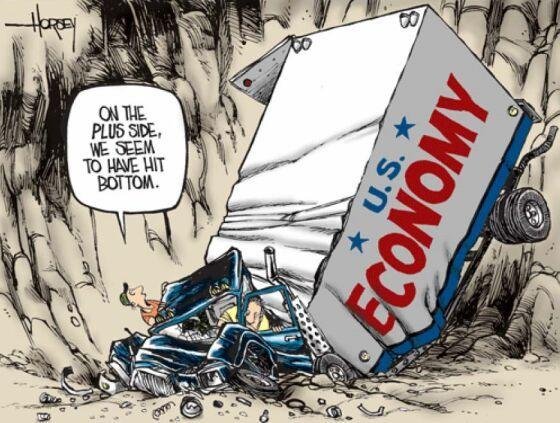

Steven has no idea how much worse.
• Unemployment Numbers ‘Will Get Worse Before They Get Better’ – Mnuchin (NPR)
The worst of the nation’s historic job losses are yet to come, according to Treasury Secretary Steven Mnuchin, who told Fox News Sunday that “the reported numbers are probably going to get worse before they get better.” Mnuchin’s comments followed Friday’s report from the Labor Department showing the U.S. lost a staggering 20.5 million jobs in April, bringing the jobless rate to its highest level since the Great Depression — 14.7%. But even that figure fails to account for the millions of workers who have stopped searching for jobs or those considered “underemployed.” Asked by host Chris Wallace whether the nation’s true unemployment rate was close to 25%, Mnuchin responded, “we could be.”
“This is no fault of American business, this is no fault of American workers, this is a result of a virus,” he said before warning, “You’re going to have a very, very bad second quarter.” Two weeks ago, Mnuchin’s outlook was more optimistic — he told Wallace that the economy would reopen through June and “bounce back” over the summer. On Sunday, he said the economy would “have a better third quarter,” followed by “a better fourth quarter, and next year is going to be a great year.” The Trump Administration is considering additional stimulus measures, including a payroll tax cut, according to Mnuchin, who also said on Sunday, “We’re not gonna do things just to bail out states that were poorly managed.” But he said the White House would wait a “few weeks” before considering another relief bill.

The BLS doesn’t have the data, so they release a report they know is false.
• A 6.4 Million Discrepancy In The Employment Report (Mish)
There is a 6.4 million discrepancy between the change in employment level and the change in unemployment level. Such is a new all time record discrepancy between employment and unemployment in the Household Survey that measures the unemployment rate. I created the lead chart as follows: Discrepancy = Change in Employment Level – (-1 * Change in Unemployment Level)
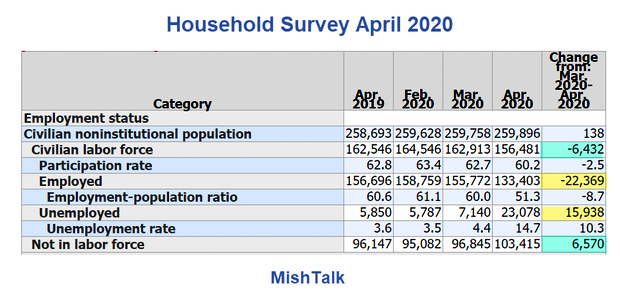
Confirmation
• The number of employed fell by 22.369 million.
• Those unemployed only rose by 15.938 million.
• Employment discrepancy is 22.369 – 15.938 = 6.431 millionNegligible Labor Force Discrepancy
• Change in Labor Force: -6.431 Million
• Change in Not in Labor Force: +6.570 Million
• The labor force discrepancy is 6.570 – 6.431 = 0.139 millionDiscrepancy Comparison
• Employment Discrepancy Percentage: 28.8%
• Labor Force Discrepancy Percentage: 2.1%Unemployment Rate Formula
• Unemployment Rate = (Unemployed / Labor Force) * 100 Therefore, the unemployment Rate = (23.078 / 156.481) * 100 = 14.7% That is how the BLS calculated the unemployment rate.Factoring in the Employment Discrepancy
• Unemployment Rate = ((23.078 + 6.431) / 156.481) * 100 = 18.6%

They’re not going to rest until there’s an anti-hydroxychloroquine law.
• Schumer Calls On VA Dep. To Explain Use Of HCQ (AP)
The Senate’s top Democrat on Sunday called on the Department of Veterans Affairs to explain why it allowed the use of an unproven drug on veterans for the coronavirus, saying patients may have been put at unnecessary risk. Sen. Charles Schumer of New York said the VA needs to provide Congress more information about a recent bulk order for $208,000 worth of hydroxychloroquine. President Donald Trump has heavily promoted the malaria drug, without evidence, as a treatment for COVID-19. Schumer’s request comes after a whistleblower complaint filed this past week by former Health and Human Services official Rick Bright alleged that the Trump administration, eager for a quick fix to the onslaught of the coronavirus, wanted to “flood” hot spots in New York and New Jersey with the drug.
Major veterans organizations have urged VA to explain under what circumstances VA doctors initiate discussion of hydroxychloroquine with veterans as a treatment option. “There are concerns that they are using this drug when the medical evidence says it doesn’t help and could hurt,” Schumer said in an interview with The Associated Press. He said given the fact the malaria drug, despite being untested, had been repeatedly pushed publicly by Trump, VA Secretary Robert Wilkie must address whether anyone at the department was pressured by the White House or the administration to use hydroxychloroquine for COVID-19.
Schumer said Wilkie also should answer questions about a recent analysis of VA hospital data that showed there were more deaths among patients given hydroxychloroquine versus standard care, including how much patients knew about the drug’s risks before taking it. Wilkie in recent weeks has denied that veterans were used as test subjects for the drug and that it was instead administered at government-run VA hospitals only when medically appropriate, with mutual consent between doctor and patient. Still, Wilkie has repeatedly declined to say how widely the drug was being used for COVID-19 and whether the department had issued broad guidance to doctors and patients on the use of the drug.
In a weekly call with veterans’ groups this past week, Wilkie continued to defend VA’s use of hydroxychloroquine. He dismissed the recent analysis of VA hospital data showing no benefits to patients, suggesting the poor outcomes were because the cases involved older, very sick veterans. He has not said whether the department will continue to use the drug. “Use of this medication for treatment of COVID-19 is considered ‘off label’ — perfectly legal and not rare,” he wrote in an April 29 letter to veterans’ groups.

Meanwhile in the real world…
Maybe this should read “French Doctors Attempt Mass Cull Of Their Patients”.
• Number Of Hydroxychloroquine Prescriptions Explodes In France (F.)
Despite the warnings around taking hydroxychloroquine to combat the symptoms of COVID-19, prescriptions in France have increased by as much as 7,000% in certain parts of the country since the pandemic began. As reported by La Provence, a study looking at the 466 million French prescriptions written since the pandemic began in France, show a huge spike in doctors prescribing the drug. In the last week of March, for instance, over 10,000 people were prescribed hydroxychloroquine in Marseille alone. In France and the U.S., the use of hydroxychloroquine has been fraught between those who think the risks are small enough to warrant widespread use and those who think that more research is required before widespread prescription.
Following research conducted in China, a French doctor, Didier Raoult–head of the IHU, the Institute of Infectious Diseases in Marseille–claimed at the beginning of March that he had successfully treated patients suffering from coronavirus with the drug. Hydroxychloroquine is an anti-malarial drug also used to treat people suffering from lupus. It is sold under its trader name of Plaquénil in France. Shortly afterwards, President Trump, tweeted the same news, that a combination of hydroxychloroquine and azithromycin could work with patients. The latter is an anti-bacterial drug, given in tandem, to eliminate the risks of bacterial infection.
Health professionals were quick to point out that no one should be using the drug without further research showing clear evidence that the drugs do work under a peer-reviewed clinical trial. Dr Anthony Fauci, Trump’s advisor downplayed the drug’s impacts as purely “anecdotal” and others issued warnings that the drug can cause severe health impacts if taken in an unsupervised capacity, such as heart problems. Before the pandemic, an average of 50 prescriptions were written each day in Marseille for hydroxychloroquine. The day after Didier Raoult announced his findings in Marseille, this had jumped to 450 per day. On March 18th, that figure had spiked again and there were 5,000 prescriptions in just one day across the whole of France.
The research authors believe that 41,000 people were given the drug between March 16 and April 19. Prescriptions have been higher in Paris and Marseille (where Didier Raoult heads the IHU, the Institute of Infectious Diseases). The study also noted that most people who were granted access to the drug across France were from higher socio-economic groups.

Indian doctors in New York. “In the absence of options such as remdesivir being available..” Well, we’ll take care of that..
• Zinc Hope In Coronavirus Fight (Telegraph India)
Doctors have reported that adding zinc sulfate, a dietary supplement, to hydroxychloroquine and azithromycin may benefit patients with coronavirus disease, adding a twist to the controversy over the rationale for prescribing hydroxychloroquine for Covid-19. Doctors at the New York University Grossman School of Medicine have found that adding zinc sulfate to hydroxychloroquine and azithromycin already given to Covid-19 patients decreased the need for ventilation or admission to intensive care units, and lowered mortality. Their study provides the first evidence through patients that zinc sulfate in combination with the other two drugs may have a role in the treatment of Covid-19, the doctors said.
Their study was posted on Friday in a database for medical research but has not been peer-reviewed yet. “The latest evidence suggests against much benefit from hydroxychloroquine, but this study raises the question of possible benefit of zinc and hydroxychloroquine together,” Joseph Rahimian, the doctor who led the research, told The Telegraph via email. The findings could be relevant to India where experts with the Indian Council of Medical Research and other institutions have introduced the hydroxychloroquine-azithromycin combination for the treatment of Covid-19 patients. Rahimian and his colleagues introduced zinc sulfate to Covid-19 patients as New York entered the ranks of cities hit the hardest by the pandemic.
They tracked the outcomes of the infections in 521 patients who received hydroxychloroquine and azithromycin and 411 who received zinc sulfate in addition to the two drugs. They observed that adding zinc sulfate was associated with a “most striking” decrease in mortality among patients who did not require intensive care. The association was not significant among patients who were treated in intensive care, implying that the addition of zinc should be considered early during treatment. “The benefit is likely to be more pronounced with its earlier use,” Rahimian said. “In the absence of options such as remdesivir being available, zinc with hydroxychloroquine may be a consideration. A randomised trial of the two versus placebo would help clarify whether there is a clear benefit and (the) extent of any potential benefit,” he added.

https://twitter.com/AlanRMacLeod/status/1258888363593150466
• Guaidó’s Mercenary Hit Contract On Maduro Mirrors Official US Bounty (MacLeod)
Juan Guaidó was expecting to be in Venezuela’s Presidential Palace by now. But the comically bungling May 3 invasion attempt by US mercenaries and opposition members was the latest indication of the desperate measures he and his cronies have resorted to. The fighters hired under his name were immediately overpowered in the sleepy coastal village of Chuao by disgruntled members of the House of Socialist Fishermen, and some of the highly trained mercenaries appeared to literally wet themselves in terror when apprehended. Now, a 41-page contract outlining the details and conditions of the coup attempt has been leaked. It sheds new light on the arrangement between Guaidó and Silvercorp, the American private security firm he hired,.
The self-declared President of Venezuela promised to pay Jordan Goudreau, founder of the Florida-based firm, $212.9 million to capture, detain or “remove” President Nicolas Maduro and install him in his place. The contract goes into detail about who the mercenaries were allowed to engage in “kinetic strikes” (i.e. assassinate and kill). It first names a number of paramilitary organizations like the Colombian FARC, and bizarrely, Hezbollah, but also on the list are a number of “illegitimate Venezuelan forces,” that include any armed supporters of Maduro and Constituent Assembly President Diosdado Cabello. Maduro and Cabello happen to be the same figures placed at the top of a US Drug Enforcement Agency hit list.
The US offered $15 million and $10 million respectively for their capture, effectively putting a bounty on the heads of the elected president and the head of his country’s main legislative body. The contract signed by Guaidó and Silvercorp also enables the killing of anyone they deem to be “armed and violent colectivos.” For a sector of Venezuela’s upper-class opposition, the term “colectivo” is a dehumanizing, oft-used catch-all term applied to any working-class person. Trade unionists, pro-government protestors, even anyone riding a motorcycle is presumed to be part of an armed and dangerous gang in the lurid fantasies of the light-skinned elitists of Eastern Caracas. Therefore, the contract essentially permits Silvercorp to kill any member of the government’s popular support base with impunity.
Perhaps more worrying, however, is what Silvercorp envisaged its role to be after a successful coup. The contract stipulates that the mercenary organization would “convert to a National Asset Unit that will act under the direction of the Administration [Guaidó] to counter threats to government stability, terror threats and work closely” with other security forces. Their missions would include, but not be limited to, surveillance, covert operations and target programming. In other words, Silvercorp would transform into a private paramilitary squad answerable only to Guaidó, crushing any opposition to his dictatorship, in much the same way death squads in Colombia and other Latin American countries have operated for decades.

Chuck Todd is a far-left TV host? Boy, you Americans really have no idea what left and right is anymore.
This is insane al the same. He should be fired.
• AG Barr’s Office Shreds Chuck Todd For ‘Deceptive Editing’ (DW)
Attorney General William Barr’s office slammed far-left NBC News host Chuck Todd on Sunday for “deceptive editing” after Todd took remarks that Barr made out of context and used the distorted remarks to smear the Department of Justice (DOJ). On “Meet The Press,” Todd used a deceptively edited portion of Barr’s interview last week with CBS News investigative reporter Catherine Herridge. Todd focused in on the following exchange between Barr and Herridge:
HERRIDGE: In closing, this was a big decision in the Flynn case, to say the least. When history looks back on this decision, how do you think it will be written? What will it say about your decision making?
BARR: Well, history is written by the winner. So it largely depends on who’s writing the history. But I think a fair history would say that it was a good decision because it upheld the rule of law. It helped, it upheld the standards of the Department of Justice, and it undid what was an injustice.Todd only played the first two sentences of Barr’s comments where Barr said, “Well, history is written by the winner. So it largely depends on who’s writing the history.” Todd then launched into an attack on Barr, saying, “I was struck … by the cynicism of the answer. It’s a correct answer. But he’s the attorney general. He didn’t make the case that he was upholding the rule of law. He was almost admitting that, yeah, this is a political job.” Todd’s comments were false because the very next thing that Barr said, which Todd did not show his viewers, was: “But I think a fair history would say that it was a good decision because it upheld the rule of law. It helped, it upheld the standards of the Department of Justice, and it undid what was an injustice.”
Barr spokeswoman Kerri Kupec responded to the segment by posting screenshots on Twitter of the transcript from what Todd said and what Barr said in his CBS News interview last week, writing: “Very disappointed by the deceptive editing/commentary by @ChuckTodd on @MeetThePress on AG Barr’s CBS interview. Compare the two transcripts below. Not only did the AG make the case in the VERY answer Chuck says he didn’t, he also did so multiple times throughout the interview.”
Today on Meet The Press, @chucktodd wildly took context out of an answer AG Bill Barr gave about his decision to drop the case into Gen. Michael Flynn.
I cut Todd's segment along with Barr's full answer together. Look at how blatantly dishonest this is. pic.twitter.com/tODOEwL48V
— Greg Price (@greg_price11) May 10, 2020

NSA, FBI, DNI have all been lying about Seth Rich for 4 years; hard to believe Mueller wasn’t in on it.
Why? They all knew the correspondence would kill off the Russian hacking story, and exonerate Assange. Couldn’t let that happen.
• DNI Has Communications Between Seth Rich and WikiLeaks For 4 Years (GP)
Recently, transcripts of a conversation between George Papadopoulos and a confidential informant believed to be Stefan Halper were released by the DOJ. This transcript confirms that Papadopoulos was spied on and recorded, two things Papadopoulos was not told at the time of the case made against him by the Mueller gang. We know from our previous reporting that a Deep State Anti-Trump former Assistant US Attorney claimed under oath that the FBI did examine Seth Rich’s computer and that she met with an FBI Agent and prosecutor from the Mueller gang. This indicates the meeting should have been recorded in a form 302 but the FBI continues to claim no records related to Seth Rich are available!
We reported in mid-February how Attorney Ty Clevenger, who represents a client who is being sued for his comments about Seth Rich, reported to the courts that despite numerous assurances from the FBI that they had no information related to Seth Rich, emails related to Seth Rich were identified and provided to Judicial Watch. It looked like the FBI was lying to Clevenger all this time. Attorney Clevenger sent a letter to ADNI Rick Grenell that he should receive by this Monday. According to Ty, the NSA, knows exactly who sent the records to Wikileaks. So does the FBI. Seth Rich is the last shoe to drop, and the Trump Admin needs to hurry up and drop it. Clevenger goes on to state the most shocking statement related to the Russia collusion sham to date:
“I am reliably informed that the NSA or its partners intercepted at least some of the communications between Mr. Rich and Wikileaks. Before elaborating on that, however, I should first note the extent to which the “deep state” has already tried to cover up information about Mr. Rich. In an October 9, 2018 affidavit submitted in a Freedom of Information Act lawsuit, FBI section chief David M. Hardy testified that (1) the FBI did not investigate any matters pertaining to Mr. Rich, and (2) the FBI was unable to locate any records about Mr. Rich. Both claims were unequivocally false.” We now know there is no evidence Russia hacked the DNC and sent the hacked emails to WikiLeaks. Crowdstrike admitted this under oath and the Mueller Report backs this up. Attorney Ty Clevenger asserts the DNI has been covering up for 4 years the fact that they have communications between Seth Rich and WikiLeaks.

We try to run the Automatic Earth on people’s kind donations. Since their revenue has collapsed, ads no longer pay for all you read, and your support is now an integral part of the process.
Thank you.

Wonderful @nntaleb venn diagram on the right way to formalize and teach probability and risk. @macroarb @zoeharcombe https://t.co/37SCp572GI pic.twitter.com/TJrUKCNTZF
— Buddy CARTER (@BuddyCA64525731) May 10, 2020
There we go, an intelligent version of libertarianism! https://t.co/GlzYqx3oWj
— Nassim Nicholas Taleb (@nntaleb) May 10, 2020

https://twitter.com/i/status/1259253115565506560

https://twitter.com/i/status/1259524909358817280

There are 2 trillion galaxies in the observable universe, each containing billions of stars.
This mind-bending animation is based on Sloan Digital Sky Survey data showing the position and appearance of 400,000 galaxies in our corner of the Cosmos. https://t.co/ClCzYcZl4y pic.twitter.com/UoWcjY7V3d
— Wonder of Science (@wonderofscience) May 10, 2020

Support the Automatic Earth in virustime.








Home › Forums › Debt Rattle May 11 2020